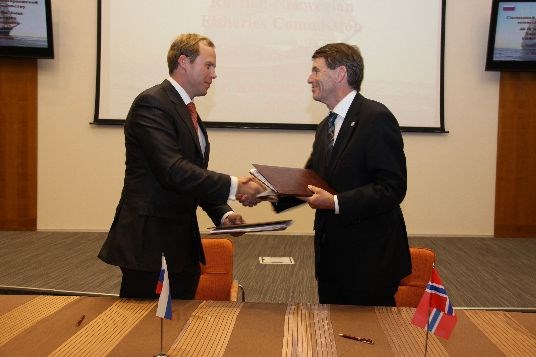2012 Norwegian-Russian fishery pact agreed
Historical archive
Published under: Stoltenberg's 2nd Government
Publisher: Ministry of Fisheries and Coastal Affairs
Press release | No: 95/2011 | Date: 18/10/2011 | Last updated: 19/10/2011
The fishery collaboration between Norway and Russia builds on mutual trust and willingness to find solutions. This collaboration has long traditions, and the parties have, thanks to its responsible, long-term and sustainable management, worked together to lay the basis for a strong stock situation and growth in most quotas for 2012, according the Minister for Fisheries and Coastal Affairs, Lisbeth Berg-Hansen, commenting on today's signing of a protocol at the end of the 40th session of the Joint Norwegian-Russian Fisheries Commission.
The fishery collaboration between Norway and Russia builds on mutual trust and willingness to find solutions. This collaboration has long traditions, and the parties have, thanks to its responsible, long-term and sustainable management, worked together to lay the basis for a strong stock situation and growth in most quotas for 2012, according the Minister for Fisheries and Coastal Affairs, Lisbeth Berg-Hansen, commenting on today's signing of a protocol at the end of the 40th session of the Joint Norwegian-Russian Fisheries Commission.

This year's meeting of the Joint Norwegian-Russian Fisheries Commission was held in Kaliningrad, and the protocol was signed by Secretary General Jørn Krog, and the vice-president of the federal fisheries agency, Vasiliy Sokolov. (Photo: Anette Aase, Directorate of Fisheries)
Over more than 30 years, the Norwegian-Russian fisheries collaboration has developed into a comprehensive and close partnership that ensures responsible management of the common stocks in the Barents Sea. The quotas that have been set for 2012 adhere to the precautionary principle and are safely within sustainable limits. The agreement also contains technical regulations for fishing activities, control measures and research collaboration.
The parties agreed the total quotas as early as the first day of negotiations.
The total quota for north-east Arctic cod in 2012 is set at 751,000 tonnes. This is an increase of 48,000 tonnes on 2011. The total quota for cod is distributed between Norway, Russia and third-party countries according to the same pattern as previous years. Norway's quota for next year will be 339,857 tonnes, including coastal cod and research catches. This is an increase of 20,000 tonnes.
The stock of haddock is thriving, and the total quota for 2012 of 318,000 tonnes represents an increase of 15,000 tonnes on 2011. The Norwegian quota will be 153,253 tonnes, including the research quota, an increase of 4,503 tonnes.
The capelin quota for 2012 has been set at 320,000 tonnes, which is a reduction of 16% on 2011. The Barents Sea capelin is managed according to a harvest control rule that ensures a spawning stock of at least 200,000 tonnes.
The quotas are based on advice from the International Council for the Exploration of the Sea (ICES).
In addition to the Norwegian quota of 191,000 tonnes, including research catches, the parties agreed a quota swap that involves Norway receiving a further 30,000 tonnes of capelin, while Russia receives 10,000 tonnes of Norwegian spring spawning (NVG) herring. This results in a total Norwegian capelin quota for 2012 of 221,000 tonnes.
The total quota for Greenland halibut in 2012 is increased by 3,000 tonnes to 18,000 tonnes.
The parties have agreed the establishment of a working group that will draw up guidelines for fishery inspections in the Barents Sea and the Norwegian Sea.